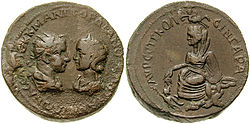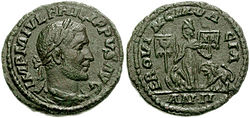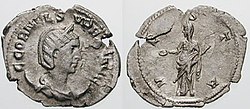Top Qs
Timeline
Chat
Perspective
Coinage from Maximinus Thrax to Aemilianus
Imperial Roman coinage from 235 to 253 A.D From Wikipedia, the free encyclopedia
Remove ads
Coinage from Maximinus Thrax to Aemilianus is understood as the set of coins issued by Rome during the reigns of more than a dozen emperors of the first part of the period called military anarchy, succeeding Severus Alexander (last of the Severan dynasty), from 235 to 253: Maximinus Thrax (235–238), Gordian I (238), Gordian II (238), Pupienus (238), Balbinus (238), Gordian III (238–244), Philip the Arab (244–249), Decius with his sons Herennius Etruscus and Hostilian (249–251), Trebonianus Gallus with his son Volusianus (251–253), and finally Aemilianus (253).
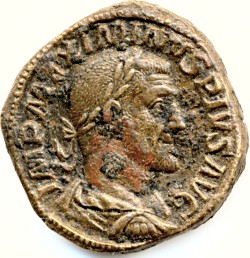
Remove ads
Historical context
Summarize
Perspective
When Alexander Severus (the last heir of the Severan dynasty) was killed at the instigation of General Maximinus Thrax, he was succeeded by the latter in 235.[1][2] Three years later, Maximinus was killed by his own troops, Legio II Parthica, encamped near Aquileia in May 238.[2][3] He was succeeded in a few months by Gordian I (who died by suicide), Gordian II (who died in battle), Pupienus and Balbinus (two senators slaughtered by the Praetorian Guard), and finally, Gordian III, who reigned until 244 but was probably assassinated at the behest of the Praetorian prefect, Philip the Arab. Philip, who succeeded Gordian on the imperial throne, fell in battle against his rival Decius in 249, who in turn died along with his son Herennius Etruscus, who would succeed him, in the battle of Abrittus against the Goths in 251.[1][3]
Decius was succeeded by Gaius Vibius Trebonianus Gallus, who associated with the throne first Decius' youngest son, Hostilianus, (in 251), and then his son, Volusianus. The latter also perished in battle at the hands of soldiers at the instigation of the future emperor Aemilianus. Aemilianus did not last more than three months, also dying at the hands of his own soldiers near Spoleto.[1][3]
Remove ads
Maximinus Thrax
Summarize
Perspective

Maximinus Thrax was the first barbarian to attain the imperial purple, thanks to the consent of the legions,[1] having been born without Roman citizenship,[4] and without being a senator.[2] He was also the first emperor never to have set foot in Rome, as he spent his three-year reign engaged in military campaigns;[1][2] and the first emperor-soldier of the third century. He died near Aquileia following a sedition of his troops.[1][2]
Main themes
Maximinus, his son Caesar and his wife Paulina
Maximinus was acclaimed Imperator, according to the version in the Historia Augusta, only after Alexander was killed. It was the first time this occurred for a military man, not yet a senator, moreover without any decree of the senate. He was also given as a colleague in the empire, his son Gaius Julius Verus Maximus, giving him the title princeps iuventutis ("prince of youth"). At the same time, his deceased wife, Caecilia Paulina, was deified. The choice of legionaries was later also confirmed by the Praetorian Guard and ratified by the Roman Senate, which, however, frowned upon an emperor of barbarian origin.[1][4]
Military campaigns against Germans and Sarmatians (235-237)
The pressure of the barbarians along the northern frontiers and the simultaneous pressure of the Sasanians in the East had spread the feeling that the empire was encircled by its enemies. The tools of traditional diplomacy, used since the time of Augustus and based on the threat of using force and the fomenting of internal dissensions among the various hostile tribes to keep them engaged against each other, now showed little effect.[1][4]
Immediate recourse to force was necessary, deploying tactically superior armies capable of intercepting every possible avenue of invasion by the barbarians as quickly as possible; however, the strategy was made difficult by having to garrison immense stretches of frontier with mostly sparse military contingents.[1][4]
To this end between 235 and 236 the emperor conducted his first campaign against the Germanic federation of Alemanni,[17] using Mogontiacum as his "headquarters" and crossing the imperial borders in the Taunus area.[18] Maximinus believed that it was a priority of the empire to wage "anti-Germanic" warfare,[3] he continued to fight the Alemanni, succeeding not only in repelling their incursions along the Limes Germanicus but also in penetrating Germania.[1] The Roman senate honored him with the title Germanicus Maximus,[6][7][8][10][19] and coins celebrated his Salus Augusta and Pax Augusti titles.
He went, then, to Pannonia, at Sirmium, for the winter of 235/236[17] and led new campaigns against the Iazyges Sarmatians of the Tisza plain, who had tried to cross the Danube after about fifty years of peace along their frontiers, and the neighboring Quadians (as some inscriptions found in the Brigetio area seem to testify).[20][21][22] He had a dream: that of emulating Marcus Aurelius and conquering free Greater Germania.[3] His headquarters, placed at Sirmium, were in the center of the Pannonia Inferior and Dacia front.[17] Thus the Historia Augusta reports:[4]
Having completed the campaigns in Germania [against the Alemanni], Maximinus went to Sirmium, preparing an expedition against the Sarmatians, and planning to subdue to Rome the northern regions as far as the Ocean.
— Historia Augusta, The Two Maximines, 13.3
Army loyalty, donativum and congiarium to provincials
Once rebellion broke out in Africa against Maximinus Thrax, Gordian I, hastened to send numerous messages to those whom he considered the wealthiest citizens of Rome, as well as to the Senate and people of Rome itself, promising great clemency for those who cooperated;[17] to the soldiers (Praetorian Guard and Legio II Parthica), a donativum was distributed; to the people of Rome a new distribution of money. Maximinus did the same, especially to the troops still loyal to him and the provincials.[17]
Remove ads
First two Gordians (238)
Summarize
Perspective

Growing general discontent towards Emperor Maximinus Thrax's rule culminated in the rebellion in Africa in March 238.[4] Gordian I, prompted by popular clamor, assumed the post and the cognomen Africanus[23][24][25] on March 22.[4][17] Given his advanced age, he insisted that his son, Mark Antony Gordianus (Gordian II), be associated with him.[1] The Senate confirmed Gordian as the new emperor along with his son, and his nephew Gordian III was promised the praetorship, consulship, and the title of Caesar, while Maximinus and his son were proclaimed "public enemies," and most of the provinces sided with Gordian I, except for a few cities still loyal to Maximinus.[4]
The reign of the first two Gordians was short-lived, as the governor of Numidia, Capelianus, who remained loyal to Maximinus Thrax,[17] invaded the province of Africa and headed for Carthage.[17] Here, Gordian II was defeated and killed in the battle of Carthage.[17] Following the death of his son, Gordian I committed suicide, hanging himself with a girdle.[17] They had reigned for only twenty days.
Coinage of the two Gordians
Remove ads
Pupienus and Balbinus (238)
Summarize
Perspective


Having supported the cause of the two Gordians, and facing the threat posed by Maximinus who was coming from the frontier, the Senate was forced to continue the struggle, naming Pupienus and Balbinus as co-emperors in the Temple of Jupiter Optimus Maximus in April 22, 238.[4][17] There was, however, an uprising by the plebs of Rome, particularly the supporters of the Gordian party, who wanted someone from the family of the defeated rebels to be elected emperor.[17] Pupienus and Balbinus agreed to appoint as Caesar the son of Maecia Faustina, the sister of Gordianus II and the daughter of Gordianus I, namely Gordianus III.[4] Pupienus, due to his military career, was sent against Maximinus as the head of the army,[4] while Balbinus remained in Rome to quell a plebeian revolt favorable to Gordianus III.[17] When Maximinus Thrax died (late April to early May),[2][4] Pupienus paid off Maximinus' troops, returned to Rome, and, along with Balbinus and Gordian III, retreated to the imperial palace.[4] Soon afterward new riots began in the city. Balbinus was later involved in the clash with Gordian III's partisans, and the city was burning from fires set by the rioters. With the presence of both co-emperors, the situation stabilized, but disquiet remained. Balbino and Pupieno both feared being assassinated by each other.[4] It was, however, the fear that the emperors, chosen by the senate, would disband the Praetorian Guard and replace it with the Germanic guard that prompted some praetorians to stage a coup. The praetorians, having penetrated the imperial palace, captured the two emperors and killed them shortly afterward. The praetorians themselves then acclaimed Gordian III as the sole emperor.[1][2] Pupienus and Balbinus had reigned for just under three months. Coins issued in their short reign show one of the two on one face and on the other, two hands clasped to symbolize their joint power.
Coinage of Pupienus and Balbinus
Remove ads
Gordian III (238-244)
Summarize
Perspective
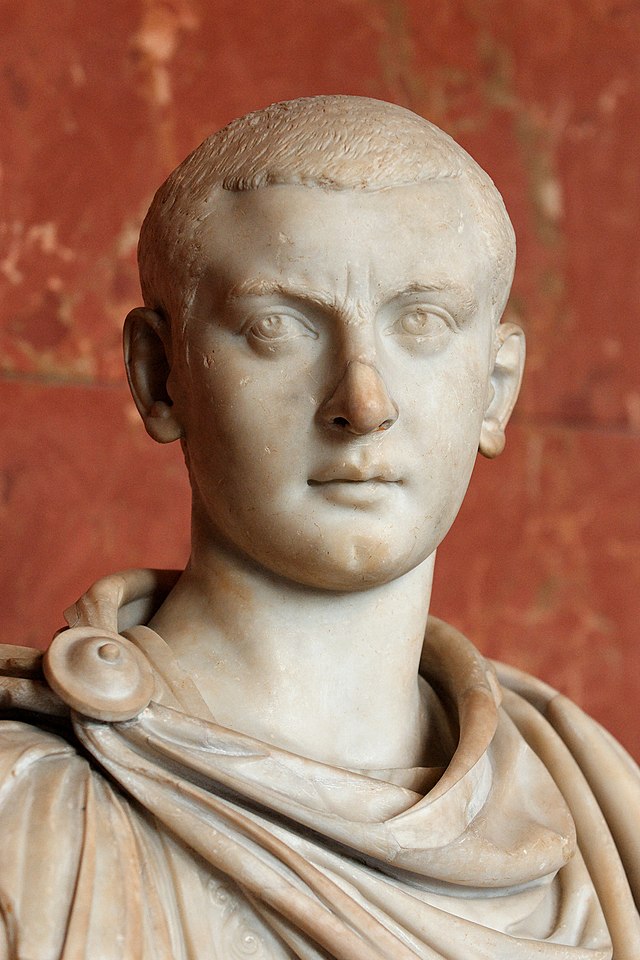
Mark Antony Gordianus (Gordian III), was Roman emperor from 238 until his death during a military campaign in the East against the Sasanians.[1][3][4] Because of his youth (he ascended the throne at the age of thirteen and reigned until nineteen), the imperial government was in the hands of regents belonging to the senatorial aristocracy. In fact, between late 240 and early 241, the emperor appointed Gaius Furius Sabinius Aquila Timesitheus prefect of the praetorium, taking his daughter as his wife.[3] Timesitheus, who had already been in administrations of several provinces, had the title of protector of the Republic.[1][3][4] As head of the praetorians and father-in-law of the emperor, Timesitheus quickly became the de facto arbiter of the Roman empire. Meanwhile, Gordian benefited from this help, becoming the symbol of the empire's unity and garnering the support of the people.[3]
Persian sources report that, in early 244, the Persians and Romans clashed at the Battle of Misiche (currently Fallujah), which ended in defeat for the Romans.[3] Shapur I changed the city's name to Peroz-Shapur ("victorious Shapur") and celebrated the victory with an inscription at Naqsh-e Rostam in which he claimed to have killed Gordian.[3] Roman sources, however, make no mention of the battle and suggest that Gordian died at Circesium, more than 300 km north of Peroz-Shapur, but do not report the cause of the emperor's death, although the prefect of the praetorium, Philip, who succeeded him on the throne, was often described as the instigator of his assassination.[1][4] Despite the opposition of the new emperor, he was deified after his death to please the people and prevent rebellion.[1][3][4]
Main themes
Wedding to Furia Sabinia Tranquillina
In late 240 and early 241 Emperor Gordian III appointed Gaius Furius Sabinius Aquila Timesitheus prefect of the praetorium and married his daughter, Furia Sabinia Tranquillina, the following summer, as also celebrated in the coinage of that year.[1][3][4]
Sassanid campaign
With the rise of the first Sasanian ruler, Ardashir I, the Persian armies returned to attacking the Roman Empire with greater force. Indeed, in 230, the Sasanian armies advanced into Roman Mesopotamia, laying siege to many Roman garrisons along the Euphrates,[17] also trying, unsuccessfully, to conquer Nisibis (a center of trade with the East and China), and possibly invading the Roman provinces of Syria and Cappadocia.[34] The following year (in 231), Emperor Alexander Severus organized a military expedition against the Sasanian armies.[17] The military campaign proved successful for the Romans, however, as the territories lost in Mesopotamia in the course of the Sasanian advance in 229–230 were recaptured, and the Sasanids remained quiet until 239–240, while Alexander earned the titles of Parthicus Maximus and Persicus.[4]
Starting in 238/239, a new large-scale invasion by the Sasanian armies led them to lay siege to the fortress city of Dura-Europos, a Roman outpost on the Euphrates.[4] The following year, Ardashir I finally succeeded in his feat of occupying and destroying the important Roman-allied stronghold city of Hatra, then occupying much of Roman Mesopotamia (including the legionary fortresses of Resaina and Singara as well as the auxiliary fort of Zagurae, nowadays Ain Sinan, perhaps also besieging and occupying Antioch, as seems to be suggested by the fact that it stopped minting coinage for the years 240 and 241.[4]
Gordian III, after mobilizing the army, marched eastward, with the command of the campaign entrusted to his father-in-law Timesitheus, and the other prefect of the praetorium, Gaius Julius Priscus.[1][4][2] The Roman armies prevailed throughout 243, repeatedly beating the Persians, taking from them Harran, Nisibis,[4][34] and Singara, and then defeating them at the Battle of Resaena. The sudden death of Timesitheus left the young emperor lacking the necessary military experience, jeopardizing the safety of his armies and himself.[4] Persian sources report that, early in the year, Persians and Romans clashed again at the Battle of Misiche, which ended in defeat for the Romans and the death of Gordian. Roman sources, however, do not mention the battle and suggest that Gordian died near Circesium,[4] leaving the suspicion that he was killed by the praetorian prefect Philip the Arab, who later succeeded him on the throne.[2]
Remove ads
Philip the Arab (244–249)
Summarize
Perspective
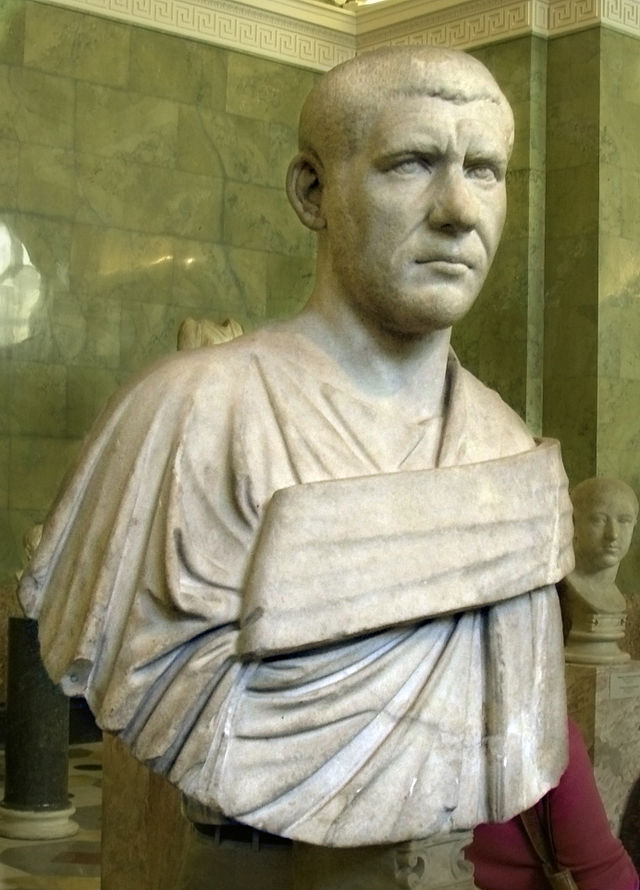
Little is known about Philip the Arab's life and political career before his ascent to the throne. He was born in Shahba in the province of Syria, a small town around 80 kilometers southeast of Damascus. In the 230s Philip married Marcia Otacilia Severa and in 238 had a son named Marcus Julius Severus Philip. In 243, during Gordian III's Sasanian campaign, the prefect of the praetorium, Timesitheus, died under obscure circumstances. At the suggestion of the other prefect, Gaius Julius Priscus, Philip's brother, the latter was appointed Timesitheus's successor, thus allowing the two brothers to control the young emperor and the empire as regents.[3][35]
Following a defeat at the Battle of Meseche, Gordian III ordered the army to retreat but died en route. Philip was, then, proclaimed emperor.[35]
Intent on not repeating the mistakes of the previous emperors, he was persuaded to go to Rome to strengthen his position in the Senate. He appointed his young son Marcus Julius Severus Philip (later co-Augustus) as Caesar. Philip's rule was, therefore, aimed at repelling the continuing invasions of the Barbarians along the Danubian Limes (245–248), earning the titles of Germanicus Maximus and Carpicus Maximus.[3][35]
A series of revolts then broke out in 248. In the East, Jotapian led a revolt against government measures and over-taxation in the territories ruled by Philip's brother Priscus.[36] In Mesia and Pannonia, Pacatian was acclaimed emperor by the troops, but the revolt was suppressed by the future emperor Gaius Messius Quintus Decius, who was then placed in charge of the two provinces. Finally, it was the turn of Silbannacus and Sponsianus, fomenters of as many revolts, which had no results.[36]
Sent to the region to punish and command the legions that had supported the usurpers, Decius was instead proclaimed emperor of the Danubian army in the spring of 249 and immediately marched to Rome. Philip's army came into contact with the usurper's army near Verona in early summer: in the ensuing battle Decius won and Philip was killed. When news reached Rome, Severus Philip, Philip's 11-year-old heir, was assassinated by the Praetorian guard.[35]
Main themes
End of the war against the Sassanids
Emperor Gordian died suddenly and his soldiers built him a cenotaph at Circesium (on the bank of the Euphrates, in the locality of Zaitha).[36] It is not known whether he died in battle or at the hands of his successor, the prefect of the Praetorium, Philip the Arab,[1][4][2][34] which resulted in the withdrawal of the Roman armies,[36] a peace judged by Zosimus, and probably the loss of part of Mesopotamia and Armenia,[34] although Philip bore the title Persicus maximus.[36] The Res gestae divi Saporis, a propaganda epigraph of the Sassanid emperor, recounts:
Gordian Caesar was killed and the Roman armies were destroyed. The Romans then made Caesar a certain Philip. Then Caesar Philip came to us to negotiate the terms of peace, and to ransom the lives of the captives, giving us 500,000 denarii, and thus became our tributary. For this reason, we renamed the locality of Mesiche, Peroz-Shapur [i.e., 'Victory of Sapur']
— Res gestae divi Saporis, lines 8–9
The Roman East was, therefore, entrusted by Philip to his brother, Gaius Julius Priscus, appointed Rector Orientis, while the defensive line in Mesopotamia was reorganized around the stronghold cities of Nisibis, Circesium, and Resaina.[35]
Thousand years of Rome’s foundation
In April 248, Philip presided over the celebration of the 1,000th anniversary of Rome, founded in 753 BC. The event was celebrated with Secular Games and a rich coinage. According to contemporary reports, the festivities included games and theatrical performances throughout the city. The coinage bears numerous subjects such as a column with the inscription MILIARIUM SAECULUM or one with the inscription COS III, or the inscription LUDI SAECULARES AUGG, or the Capitoline she-wolf suckling Romulus and Remus, a lion, a deer, an antelope, a hexastyle temple with the statue of Rome in the center and the inscription SAECULUM NOVUM.[3][35]
War in the Danubian Limes
Philip's rule began with military campaigns against the peoples north of the Danube. In 246 he reported a great success against the Germanic peoples of the Quadi along the Pannonian front, thanks to which he was given the appellation "Germanicus Maximus". In 247, the Roman offensive resumed along the lower Danubian front against the Carpi, so he was given new honors and the title "Carpicus maximus".
In 248 there was a new incursion of Goths, who had been refused the annual contribution promised by Gordian III, and of the Carpi, their associates, to the province of Lower Moesia. The invasion was eventually stopped by Philip the Arab's general, Decius Trajan, the future emperor, at the city of Marcianopolis, which had remained under siege for a long time.
Remove ads
Decius Trajanus (249–251)
Summarize
Perspective
The historical sources for Decius' life are fragmentary and make it hard to reconstruct the history of his reign and his origins. It is known from Aurelius Victor that he was a career military man of Illyrian origin, the forerunner of the so-called Illyrian emperors, and that this characteristic was celebrated in his coinage with the inscriptions PANNONIAE or GENIVS EXERCITUS ILLVRICIANI.[1]
During his reign, Emperor Decius tried to lift the spirits of the empire, which had fallen into crisis in the third century, by relying on the restoration of tradition, but his choice was shown not suitable for a state that was changing rapidly. He was unable to counter the Germanic invasions.[3]
Decius's power had its basis in the senatorial aristocracy and the army, and to both he presented himself as the restorer of tradition, through appropriate propaganda, including monetary propaganda, and by taking up those traits of the princeps that recalled the late Republic and early Empire. Politically, Decius revalued republican offices. He assumed for himself the consulship for each year of his reign; he restored the censorship magistracy by appointing Publius Licinius Valerian as censor; he assumed command of troops on the battlefield and bestowed honors on soldiers regardless of their rank.[3]
He harkened back to the dynasty of the Five Good Emperors by taking the name Trajan in honor of and in reference to the emperor Trajan. He resumed, after twenty years, a public building program in Rome: he restored the earthquake-damaged Colosseum and built the Baths of Decius on the Aventine.[3]
He sought, finally, to establish a dynasty, as Philip had done before him: his sons Herennius Etruscus and Hostilianus received the title of caesar, with Erennius then elevated to the rank of Augustus in 251; Herennia Etruscilla was appointed Augusta.[3]
Main themes
Remove ads
Trebonianus Gallus (251–253)
Summarize
Perspective

Gaius Vibius Trebonianus Gallus was Roman emperor from 251 to 253 along with his son Volusianus. His reign was marked by a long series of disasters, such as the plague that struck Rome for years, the incursions of barbarian populations beyond the empire's borders, and the loss (according to some sources that occurred during his reign) of Syria to the Sasanians. He imprinted part of his program in the wording of the coins he had minted: Pax aeterna.[3]
Main themes
Remove ads
Aemilianus (253)
Aemilianus was Roman emperor in 253 for three months, ascending to the throne after overthrowing Trebonianus Gallus. Shortly thereafter, he was defeated by Valerian, who became, along with his son Gallienus, the new Augustus. He was initially acclaimed Imperator by the troops of Mesia, after leading the Roman armies to victory against the Goths (July 253).[3][36]
Main themes
See also
References
Bibliography
Wikiwand - on
Seamless Wikipedia browsing. On steroids.
Remove ads



















